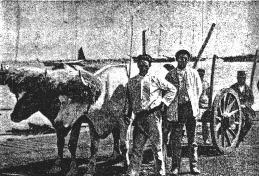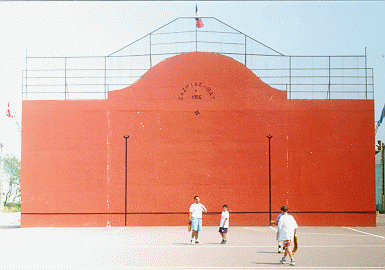Near Newfoundland,
Canada, there is a small group of islands that still remains part of France to
this day and who's population came from Normandy, Brittany and of course the
Basque country!
Very few people
know about Saint-Pierre et Miquelon. Located some 800 miles northeast of
Boston, these islands were a fishing hub for centuries.
Some will say
Saint-Pierre and Miquelon is one of North America's best-kept secrets. This is
no sunny Caribbean destination, nor is it a tourism Mecca, but being off the
beaten path is what makes this island a charming place to escape from the
hustle and bustle of modern living.
 What is most
fascinating about this island is the strong presence of the Basque spirit. In
fact the name MIQUELON
is of Basque origin and was first noted in Martin de Hoyarçabal's famous
navigational pilot for Newfoundland. Printed in Bordeaux, France, this work was
later translated into Labourdin Basque by Pierre Detcheverry. It is in this
document that the island of MIQUELON is first named. Meaning "Michael" in
Basque, Miquelon was a fishing station for several "Michaels" including
Miquelon de Aramburu. Saint-Pierre was also used as a seasonal base for a
Basque captain: Juanes de Liçaurdi -- who fished for Adam de Chibau of
Saint-Jean de Luz -- established a fishing station on the southern coast between
1602 and 1611.
What is most
fascinating about this island is the strong presence of the Basque spirit. In
fact the name MIQUELON
is of Basque origin and was first noted in Martin de Hoyarçabal's famous
navigational pilot for Newfoundland. Printed in Bordeaux, France, this work was
later translated into Labourdin Basque by Pierre Detcheverry. It is in this
document that the island of MIQUELON is first named. Meaning "Michael" in
Basque, Miquelon was a fishing station for several "Michaels" including
Miquelon de Aramburu. Saint-Pierre was also used as a seasonal base for a
Basque captain: Juanes de Liçaurdi -- who fished for Adam de Chibau of
Saint-Jean de Luz -- established a fishing station on the southern coast between
1602 and 1611.
However, it was
during the XIXth century that Basque immigration was renewed and many Basques
settled in Saint-Pierre. The Basques who came to Saint-Pierre et Miquelon were
mainly from five areas: Guéthary - Bidart, Saint-Jean-de-Luz - Ciboure,
Urrugne, Hendaye and Saint-Pée. Other Basque migrants were born on the other
side of the French-Spanish border (Fontarabie, Irun), and some came from as far
as Saint-Etienne de Baïgorry.
 American travel
writer George Allan England mentions the Basque presence in Saint-Pierre in his
"Islands of Romance", published in 1929: "I returned along the road
with a gleam of bright sunlight falling over my shoulder. At a farm I observed
an old man with huge trousers of meal sacking, engaged in sawing wood with a
bucksaw which he held between his knees, rubbing the stick up and down on the
teeth. The old man's red sash told me he was a Basque. His wrinkled face, bright
eyes, and sweeping moustaches would have warmed a painter's heart. He was a
very voluble old fellow, and for half an hour he told me words and phrases in
the mysterious and little-known Basque tongue. No foreigner, I believe, has
ever learned to speak it well, and one must be born a Basque to fathom its
complexities. Sailors claim the only outsider who has ever learned Basque is
the Old Boy himself."
American travel
writer George Allan England mentions the Basque presence in Saint-Pierre in his
"Islands of Romance", published in 1929: "I returned along the road
with a gleam of bright sunlight falling over my shoulder. At a farm I observed
an old man with huge trousers of meal sacking, engaged in sawing wood with a
bucksaw which he held between his knees, rubbing the stick up and down on the
teeth. The old man's red sash told me he was a Basque. His wrinkled face, bright
eyes, and sweeping moustaches would have warmed a painter's heart. He was a
very voluble old fellow, and for half an hour he told me words and phrases in
the mysterious and little-known Basque tongue. No foreigner, I believe, has
ever learned to speak it well, and one must be born a Basque to fathom its
complexities. Sailors claim the only outsider who has ever learned Basque is
the Old Boy himself."
Today, Basque
names are ever present in Saint-Pierre and Miquelon. Many families sport such
names as Albistur, Apesteguy, Arrossaména, Borotra, Capendeguy, Dagort,
Detcheverry, Etcheberry, Etcheverry, Goïcoëchea, Hacala, Haran, Légasse,
Luberry, Olano, Sabarotz, Télétchea, Urtizberea and Urdanabia
to name only a few...
This year, the
Basque associations of Saint-Pierre are celebrating a double anniversary: the
25th anniversary of the Basque festival, which will be held between
the 19th and the 27th of August, and the 100th
anniversary of the town's FRONTON, aptly named the Zazpiak Bat.







 What is most
fascinating about this island is the strong presence of the Basque spirit. In
fact the name MIQUELON
is of Basque origin and was first noted in Martin de Hoyarçabal's famous
navigational pilot for Newfoundland. Printed in Bordeaux, France, this work was
later translated into Labourdin Basque by Pierre Detcheverry. It is in this
document that the island of MIQUELON is first named. Meaning "Michael" in
Basque, Miquelon was a fishing station for several "Michaels" including
Miquelon de Aramburu. Saint-Pierre was also used as a seasonal base for a
Basque captain: Juanes de Liçaurdi -- who fished for Adam de Chibau of
Saint-Jean de Luz -- established a fishing station on the southern coast between
1602 and 1611.
What is most
fascinating about this island is the strong presence of the Basque spirit. In
fact the name MIQUELON
is of Basque origin and was first noted in Martin de Hoyarçabal's famous
navigational pilot for Newfoundland. Printed in Bordeaux, France, this work was
later translated into Labourdin Basque by Pierre Detcheverry. It is in this
document that the island of MIQUELON is first named. Meaning "Michael" in
Basque, Miquelon was a fishing station for several "Michaels" including
Miquelon de Aramburu. Saint-Pierre was also used as a seasonal base for a
Basque captain: Juanes de Liçaurdi -- who fished for Adam de Chibau of
Saint-Jean de Luz -- established a fishing station on the southern coast between
1602 and 1611.
 American travel
writer George Allan England mentions the Basque presence in Saint-Pierre in his
"Islands of Romance", published in 1929: "I returned along the road
with a gleam of bright sunlight falling over my shoulder. At a farm I observed
an old man with huge trousers of meal sacking, engaged in sawing wood with a
bucksaw which he held between his knees, rubbing the stick up and down on the
teeth. The old man's red sash told me he was a Basque. His wrinkled face, bright
eyes, and sweeping moustaches would have warmed a painter's heart. He was a
very voluble old fellow, and for half an hour he told me words and phrases in
the mysterious and little-known Basque tongue. No foreigner, I believe, has
ever learned to speak it well, and one must be born a Basque to fathom its
complexities. Sailors claim the only outsider who has ever learned Basque is
the Old Boy himself."
American travel
writer George Allan England mentions the Basque presence in Saint-Pierre in his
"Islands of Romance", published in 1929: "I returned along the road
with a gleam of bright sunlight falling over my shoulder. At a farm I observed
an old man with huge trousers of meal sacking, engaged in sawing wood with a
bucksaw which he held between his knees, rubbing the stick up and down on the
teeth. The old man's red sash told me he was a Basque. His wrinkled face, bright
eyes, and sweeping moustaches would have warmed a painter's heart. He was a
very voluble old fellow, and for half an hour he told me words and phrases in
the mysterious and little-known Basque tongue. No foreigner, I believe, has
ever learned to speak it well, and one must be born a Basque to fathom its
complexities. Sailors claim the only outsider who has ever learned Basque is
the Old Boy himself."





